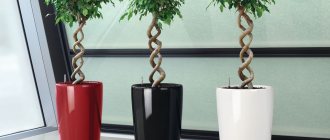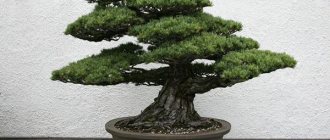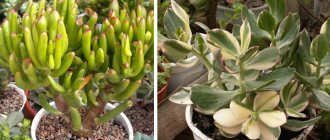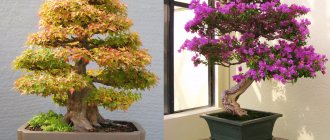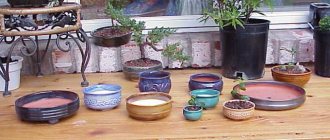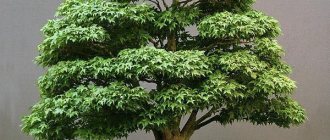Making bonsai with your own hands
You can create a mini-copy of natural wood yourself at home. To achieve the desired effect, you need to know certain growing features. To do this you will need to prepare:
- pot;
- priming;
- materials and tools for planting.
Azalea bonsai
The plant requires long-term and careful care. But, if you make all the necessary efforts, this natural creation will become a real highlight in the interior.
Preparation of material for growing
Selecting seeds or planting material for germination
The process of growing bonsai at home can take several years. First of all, you need to germinate the seeds. Then the owner of the plant needs to carefully take care of the seedlings. And only then will it be possible to form a tree.
It is not always possible to grow bonsai from seeds the first time. If you plan to grow a decorative mini-tree on the balcony, it is recommended to give preference to tropical species. These include:
- laurel;
- Korean lemon;
- dracaena;
- a coffee tree.
Beginners are recommended to try growing ficus bonsai. This is an unpretentious plant that does not require special care. You can also plant pine or fir, which grows very slowly, but turns into a beautiful tree.
Mini laurel tree
Choosing a pot for bonsai
Regardless of the type of plant you will use to grow your bonsai, the pot should be wide and shallow. Thanks to this, proper growth and development will be ensured. The owner of the plant will be able to properly control the branching of roots and form the crown. The right container should have large drainage holes. To prevent the soil from spilling out, you need to place a net on one of them. It is not allowed to have designs, beads, or seed beads on the inside of the pot. Plain colored containers are best.
Bonsai soil
Soil is of great importance for growing a decorative mini-tree. It should be soil enriched with nutrients that retains moisture well. It is recommended that the mix include:
- swamp clay, which ensures a uniform supply of nutrients; it is best to use clay granules;
- volcanic sand - it increases the porosity of the earth and oxygen permeability;
- river sand – retains moisture;
- humus is natural humus that accumulates and releases nutrients well;
- the last component is pumice, it absorbs nutrients and moisture well, and then distributes them throughout the plant. This component promotes the proper formation of roots and prevents them from growing deep inside the container.
Do I need to fertilize bonsai?
It is very important to properly care for the soil during bonsai growth. Since mini trees have a very branched root system, they need as many minerals as possible. Therefore, plants need additional feeding. The main fertilizers to be used are:
- nitrogen;
- phosphorus;
- potassium.
Feeding should be balanced and have a ratio of 12 units of nitrogen, 6 phosphorus and 6 potassium.
Note! It is possible to stimulate the growth of a mini-tree only with the ratio of all three elements (nitrogen, phosphorus, potassium), and not each of them separately!
How long does a bonsai grow?
There are two periods in the process of growing bonsai:
- For several years the owner has to care for the seeds.
- The second stage is the main one – growing and caring for the sprout.
In Japan, such trees have been grown for centuries, passed down from generation to generation. There are trees that are already about 4,000 years old. The most durable mini-trees are conifers.
Crown shapes for bonsai
There are many varieties of bonsai forms:
- formal and informal vertical;
- fan;
- semi-cascade and cascade;
- fallen or dead tree;
- double barrel
To learn how to properly shape a growing tree, you can attend specialized master classes.
Types of crowns
When to replant
Until the age of five, the plant must be replanted every year in the spring. The soil must be completely replaced. Once the plant is 10 years old, planned replanting becomes necessary only every 10-15 years.
After the procedure, the bonsai should not be placed in direct sunlight for two weeks.
Important! The need to replant may be necessary urgently when the roots of the tree begin to rot.
Types and techniques
There are different types of bonsai, but they are all grown using two techniques:
- Traditional.
- Special.
Today, special techniques are less popular than traditional ones. Only knowledgeable gardeners use it. It involves growing bonsai in styles such as miniature landscape, common roots, wind-blown, and rock-grown. Each of these styles has its pros and cons, but not everyone can master them.
Traditional technology is used as the main one by almost all amateur gardeners. It also includes several different styles, including group, oblique, half-cascade, cascade, literary, straight formal, straight informal and composition.
The variety of types and subspecies of bonsai is amazing. Plants are grown from both seeds and cuttings.
Juniper Bonsai
Bonsai - DIY home care
Juniper bonsai is an excellent choice for both beginners and seasoned professionals. This beautiful tree will be a great addition to any room.
An unpretentious plant for beginner bonsai growers
The main advantage of a juniper mini-tree is its unpretentiousness. In winter, the plant needs rest, so even its watering is reduced to a minimum.
Miniature juniper tree
Requirements for humidity, temperature and lighting
A mini juniper tree will do best with at least four hours of sun per day. And the soil should have a tendency to dry. It is helpful to allow the soil to dry completely between waterings.
Important! Much attention should be paid to the drainage system in the flower pots. If the water does not pour out, but remains in the pot, this will lead to rotting of the roots.
Feeding juniper
It is recommended to feed the plant once every three weeks. In spring, fertilizers with a high nitrogen content are best suited as fertilizers. In autumn, its level, on the contrary, needs to be reduced. For the summer period, a balanced fertilizer is recommended.
Crown formation
The structure of the trunk is not rigid, therefore, unlike other plants, it can be bent. Thanks to this property, wire can be used to form the crown. It is wrapped around the plant and the trunk is tilted horizontally towards the table. We must ensure that during the growth process the wire does not grow into the bark!
Trimming leaves and branches
Juniper bonsai are pruned in spring and autumn. New shoots must be removed when they reach several centimeters in length. The roots of the tree should be trimmed every two years.
Plants that are suitable for growing in our environment:
- Common lilac, Hungarian lilac, White lilac, White variegated lilac;
- Spiraea japonica, Spiraea middle, Spiraea birch-leaved, Spiraea prostrate;
- Irga alder, European forsythia, common cherry, steppe cherry;
- Siberian spruce, prickly spruce, prickly gray spruce, globular willow, weeping willow, Ledebura willow;
- Berry apple tree, Sievers apple tree, Cossack juniper;
- Siberian larch;
- Low almond, bean, varietal mock orange;
- Viburnum foliage;
- Common viburnum, River maple;
- Aronia cotoneaster, European euonymus;
- Ussuri pear, Hawthorn;
- Silver birch; Thunberg's barberry;
- Barberry purple, Barberry Amur.
Ficus bonsai
DIY money tree bonsai
Most often, ficus is chosen to create a bonsai. Thanks to its strong stem, powerful roots, and good growth rate, it is possible to correctly form a miniature tree.
What types of ficus are suitable for bonsai?
The following types are suitable for growing a miniature ficus tree:
- rusty red;
- Benjamin;
- Bengal.
Ficus benjamina bonsai is the most suitable option, since the plant has all the necessary characteristics for a mini-tree.
Mini ficus tree
Choosing bonsai plant forms
Depending on the shape of the trunk, there are six styles of forming miniature trees:
- inclined Shakkan - the tree is located at an angle of 60 degrees. An important feature is that the first branch must be placed against the slope;
- Hokidachi - branched apex with a straight trunk;
- trunk bifurcation - Shokan;
- A grove is a composition of several plants;
- Moyogi - the trunk grows in the shape of an S;
- Tekkan - the trunk grows with a narrowing from the roots to the top.
Beginners are recommended to start with the Tekkan style.
A Practical Guide to Shaping a Ficus Tree
The step-by-step process of giving the plant its shape consists of three types of processing:
- roots;
- crowns;
- trunk
In order for the tree to grow in breadth, its roots are cut off until the trunk begins to thicken. After this, the leaves and stems are trimmed. The procedure is carried out only in summer and spring.
The trunk is formed using wire. The plant must be tied to give the required slope. Then the winding is made in the form of a frame. Thanks to it, the branches are strengthened.
Description
Bonsai is a concept that implies the cultivation of miniature copies of trees using a special technique. Such plants look very beautiful in pots and help create a cozy atmosphere in the room.
Bonsai cultivation first began in China due to the decree of the emperor, who ordered the creation of an exact copy of the Chinese empire, including plants and trees. A method was invented that made it possible to grow ordinary trees in a reduced form, which has since become very popular not only in China, but also beyond its borders.
You can learn more about growing bonsai from our article, where you can also find step-by-step instructions and an interesting video about the types and techniques of cultivation.
Money tree or Crassula bonsai
DIY pine bonsai in the garden
Crassula bonsai is well suited for any technique, since it can be used to make a compact plant of an original shape.
Description of Crassula and types for bonsai
The money tree can reach a height of 1.5 m. It is distinguished by thick stems and decorative gray-green leaves. For miniature trees, tree-like crassulas are used.
Money Tree Bonsai
Preparing planting material
Before planting, the trunk of the money tree must be properly trimmed, as it is curved, and maintained in shape as it grows. The height of such a tree will not exceed 20 cm.
Planting plants in prepared substrate
Money tree bonsai will grow well in cactus soil. The soil should be loose and allow air to pass well, which is necessary for the proper formation of the root system.
Formation of the Crassula crown
You can start decorating the crown as soon as three pairs of leaves appear. When creating a crown, the desired shape of the future plant should be taken into account. The most important thing is to identify the stems that should be developed into branches.
Bonsai carmona - the most popular plant
Carmona is one of the most common plants for forming mini-trees. Its main feature is its attractive appearance and minimal maintenance.
Bonsai for beginners or why karmona is suitable for beginners
Beginner gardeners are recommended to create bonsai from carmon. It is an evergreen bush with beautiful dark leaves. Once a year it begins to bloom. Small berries appear on the shoots. The plant is not capricious and easy to grow.
Carmona for growing bonsai
Unpretentious plant for bonsai
The plant grows well even in dark places. It only needs a few hours of sunlight a day. If proper lighting is provided, carmona blooms all year round.
Temperature and lighting
Carmona is a plant of the tropics; it loves the heat, but can survive at 10 degrees. In winter, even an hour of sunlight is enough for him.
Growth rate
Unlike azalea, carmona bonsai grows quite quickly; in a few years the plant turns into a beautiful bush.
Earth mixture
Carmona bonsai should grow in a clay substrate. You can make it yourself using a mixture of leaf and turf soil with the addition of garden loam. The plant will develop well in inorganic soil, but in such a situation it is necessary to provide the tree with regular feeding.
Important ! There should be no lime in the ground; the plant's leaves will begin to fall off, which can lead to death.
Types of karmona for indoor cultivation
The most popular varieties for growing are large-leaved and small-leaved carmonas. At room temperature they will bloom all year round. At the same time, the methods of caring for them do not differ from myrtle bonsai.
Zanthoxylum
This plant is also known to us as yellowwood and pepper tree, although the fragrant leaves of the plant do not smell like pepper, but like lemon, since zanthoxylums are relatives of citrus fruits. It is this crop that brings the harvest of the legendary Sichuan pepper.
Zanthoxylum is often viewed as a plant for greenhouses only, but in fact, it is one of the most unpretentious types of indoor bonsai.
Pepper tree is an evergreen tree and shrub, most often grown in bonsai as a tree with a single trunk. The plant is characterized by beautiful, dark bark with an unusual golden-grayish tint and a very dense large-leaved crown.
The feathery leaves of Zanthoxylum, which emit a pleasant lemon aroma when touched, are dark green in color and can reach a record length of 15 cm for a bonsai. Zanthoxylum blooms from April to June. The plant produces dioecious golden flowers in small panicles of inflorescences.
For bonsai, you need to ensure stable soil moisture by watering frequently, but with a small amount of water. Rainwater is more suitable for zanthoxylum. When choosing conditions, it is worth focusing on the brightest window sills - sunny places, regardless of the time of year. Zanthoxylum should be protected from exposure to air conditioners or heating devices. The plant does not have to be taken out into the fresh air for the summer.
The formation of zanthoxylum must be carried out constantly, pruning young branches to create the desired silhouette. If the plant has been shaped to a certain shape, then the young shoots are cut back to their original contours, preventing them from growing in length.
In winter, zanthoxylums are kept cool, but the plant cannot tolerate temperatures dropping below 10 degrees Celsius. The optimal temperature value is from 12 to 15 degrees.
Ammania - bonsai in an aquarium
Ammania bonsai is a real garden in an aquarium. The plant will look like a dense carpet of greenery with pink tops.
Bonsai in an aquarium
Conditions and care for ammania
The plant itself is very fragile, so it cannot be grown in an aquarium where large fish live, they can damage it. To speed up the growth of the mini-tree, you can increase the supply of carbon dioxide.
Bottom substrate
Fine and light sand is excellent for ammania soil. It is recommended to fertilize it with iron. The plant blooms in four cups, located separately from each other.
Water temperature, hardness and lighting
The plant adapts well to fresh water and hardness levels from 3 to 8. The water temperature should be no higher than 28 and no lower than 22 degrees. For a tree to grow actively, it needs good lighting.
Ammania cuttings
Ammania bonsai is grown only from cuttings. The growth of the plant depends on how well the cuttings are carried out. It is necessary to pinch off from the main trunk. The cut cuttings are placed in the substrate. As soon as the roots appear, you can transplant the cuttings into the prepared soil.
Knowing the nuances of how to grow bonsai from seeds at home, you can create an unusually beautiful tree that will become a real interior decoration.
